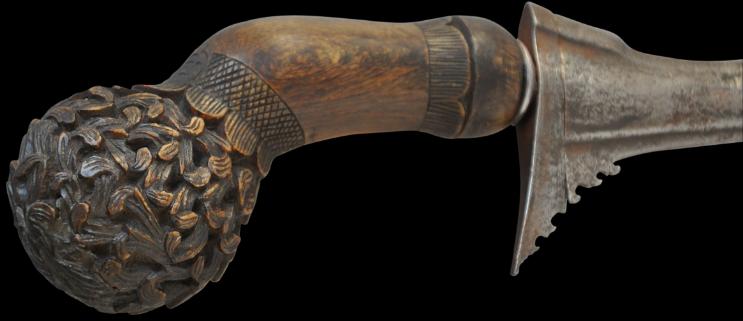Detail: Crucifix stamped to the side of the bowl.
VOC Kris from Sumatra
Straight-bladed Executioner’s Kris Panjang Impressed with VOC Mark
Sumatra, Indonesia
17th-18th century
length: 67cm
This long and thin straight-bladed kris (kris panjang) is indigenous to Sumatra, compared with the wavy-bladed krises of Java and Bali. Such swords in Sumatra were used by officers who preceded the Raja. They were also known as kris penyalang because this type generally was used for executions.
This example has a finely and intricately carved wooden handle. Importantly, the damascened iron blade is impressed on both sides with ‘VOC’ and ‘A’.
VOC in this instance stands for
Verenigde Oost-Indische Compagnie – the Dutch East Indies Company. The ‘A’ denotes the Amsterdam chamber of the VOC.
The VOC consisted of six chambers (
kamers) in the following Dutch port cities: Amsterdam, Delft, Rotterdam, Hoorn, Enkhuizen and Middelburg. Delegates of these chambers convened as the Heeren XVII (the Lords Seventeen) which oversaw the VOC as a whole.
The VOC logo was applied to certain types of property of the VOC such as coins, crockery and most particularly to canons. For items specific to a particular operation – weaponry such as canons – the first letter of the hometown of the chamber conducting the operation was placed on top (such as ‘A’ for Amsterdam in the example here.)
Zandvliet (2002, p. 338) describes a cannon made at the VOC foundry in European in Batavia style in 1667 which was seized in 1858 by Dutch troops during an expedition against the Sultan of Jambi. The cannon was similarly marked with the VOC monogram and the ‘A’ for the Amsterdam chamber. It is likely that the Jambi sultanate had captured this canon from the VOC during the seventeenth century.
It is likely that this
kris with its impressed ‘VOC A’ marks was a captured weapon subsequently branded as VOC property with the ‘VOC A’ logo.
A 17th-18th century dating for this
kris is detrmined by the history of the VOC. The VOC was established in 1602 as a chartered company and was given an initial 21 year monopoly to undertake its trading activities in Asia. The monopoly was extended for a period of almost 200 years during which time it became the richest and most important trading company between Europe and Asia.
The VOC was all but bankrupted after the Fourth Anglo-Dutch War. The provincial States of Holland and Zeeland attempted to reorganise it, but it was nationalised on March 1, 1796. Its charter was renewed several times subsequently, but was allowed to expire on December 31, 1800, after which the company was formally dissolved.
References
Woolley, G.C., ‘The Malay keris: its origin and development’ in Journal of the Malayan Branch of the Royal Asiatic Society, December 1947; &
Zandvliet, K.
et al, The Dutch Encounter with Asia 1600-1950, Rijksmuseum Amsterdam, 2002.
Provenance
Scottish art market.
Inventory no.: 1131
SOLD
Detail: Crucifix stamped to the side of the bowl.







